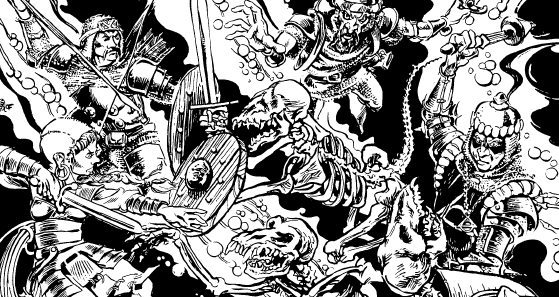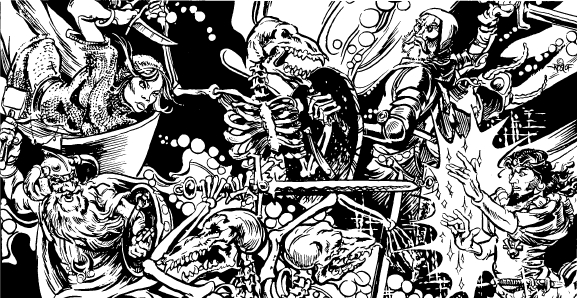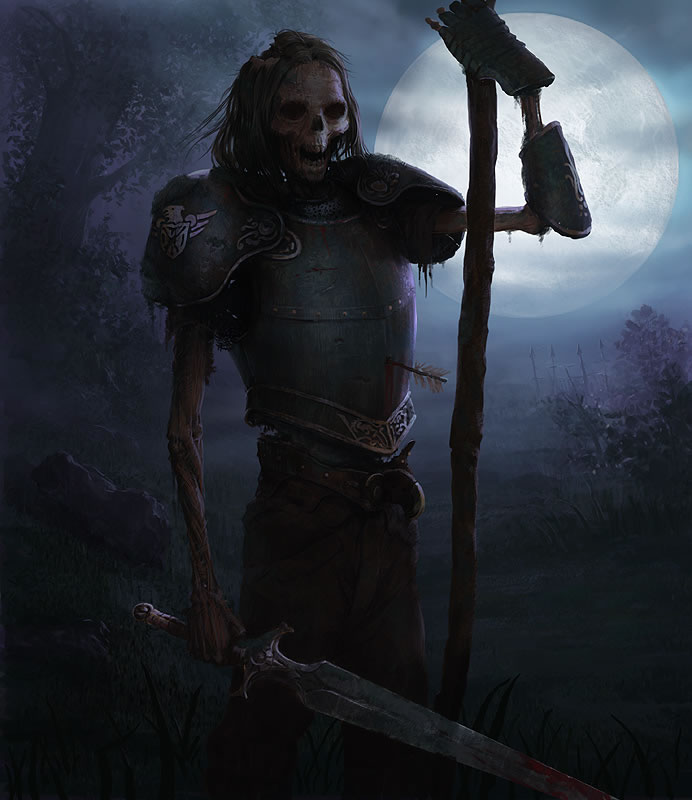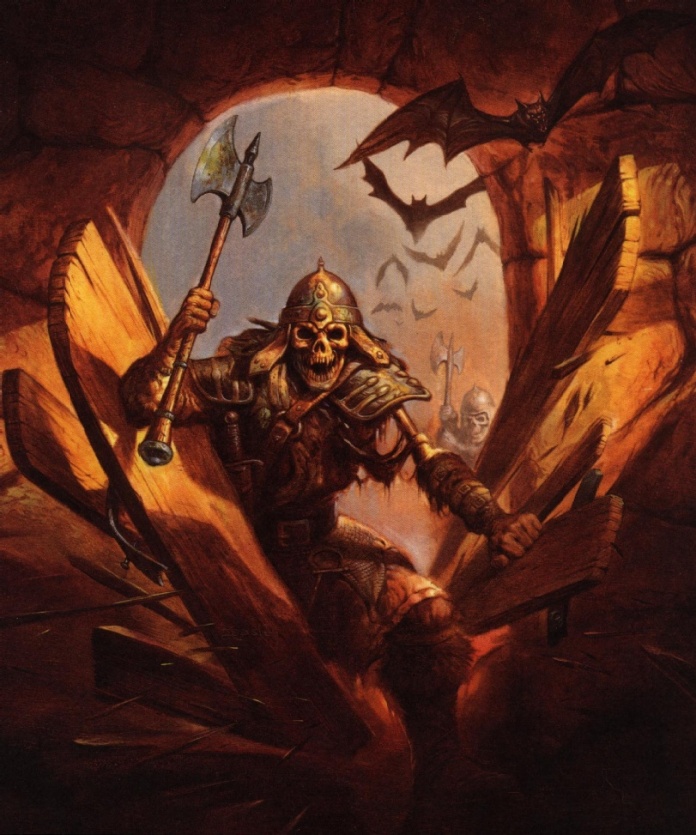

FREQUENCY:
Rare ([Dungeon Level I])
FREQUENCY: Rare
([Cold Civilized Swamp]), ([Cold Wilderness Swamp])
FREQUENCY: Rare ([Temperate
Civilized Swamp])
FREQUENCY: Rare ([Temperate
Wilderness Swamp])
FREQUENCY: Rare
([Tropical Civilized Swamp], [Tropical Wilderness Swamp])
NO. APPEARING: 3-30
ARMORCLASS: 7
MOVE: 12"
HIT DICE: 1 ~ 19
% IN LAIR: Nil (52 Skeletons:
desert, TPL18:3rd, REF3.83)
TREASURE TYPE: Nil
NO. OF ATTACKS: 1
DAMAGE/ATTACK: 1-6
SPECIAL ATTACKS: Nil
SPECIAL DEFENSES: Sharp
weapons score half damage only
MAGIC RESISTANCE: See below
INTELLIGENCE: Non-
ALIGNMENT: Neutral
SIZE: M
LEVEL/X.P. VALUE: I | 14
+ 1
SAVES: (14)16.17.18.20.19
MORALE: 100%
Skeletons are magically animated,
undead monsters. They are enchanted
by a powerful M-U
|| cleric of evil alignment. The skeletons
perform according to the
command of their animator -- the command
being limited in scope to
but a dozen or two words. They are found only in
burial places or dungeons
and similar forsaken places.
The skeleton strikes with
some form of weapon, but regardless of the
weapon type the damage caused
by a hit will be 1-6 hit points.
Skeletons suffer only one-half
damage from sharp and/or edged weapons
(such as spears, daggers,
swords). Blunt weapons such as clubs, maces,
flails, etc. score normal
damage. Fire scores normal damage. Sleep,
charm, hold
and cold-based spells do not affect skeletons. Holy water
causes 2-8 HP of damage
on a skeleton for each vial which strikes it.
Skeletons attack until destroyed.
The skeleton is the sacred animal of Yurtrus.
<link 2 holographic map of the skeletal system>
<T3.49: Skeletons, gnoll (6): AC 7, MV 9", HD 2, hp
12, 11, 10, 9, 8, 7; #AT 1, D 2-7; XP 52,
50, 48, 46, 44, 42>

Lizard man skeletons (I7.30)

Question: When a character
attacks a skeleton with a piercing weapon,
is the character’s strength--damage
adjustment added to the
number of points of damage
inflicted on the creature?
Answer: Skeletons
take half damage from attacks by sharp weapons
--in other words, half of
the points of damage that would have
been suffered by a creature
which does not have that partial
protection. The result of
the attack is computed normally, the
bonus to damage (if any)
is added to the full result, and then the
damage points are halved.
e.g.,
a character with <alt>
strength 18 (+2 to damage)
hits a skeleton with his long sword
and does 4 points of damage
with the weapon. The skeleton will
take 3 points of damage
from that attack (4 + 2 equals 6, divided
by 2 equals 3), as opposed
to the 6 points of damage it would
inflict on a creature which
is fully vulnerable to edged weapons.

Q: In the DUNGEONS
& DRAGONS
ENDLESS QUEST book "Pillars
of
Pentegarn,"
the party is attacked by a
dragon skeleton. In the
Players
Handbook, it states
that only humans can <qv. animate dead>
be animated. What's correct?
A: All of the new
ENDLESS QUEST
books from TSR are based
on the
DUNGEONS & DRAGONS game
system, which is different
from the
AD&D game procedures.
In AD&D
games, humanoid skeletons
are the limit,
but that includes giants
(needing high
level clerics).
If you haven't gotten these
books,
check them out. They're
exciting
adventures, with lively
characters and
story lines plus excellent
art all the way
around. The reader makes
decisions
along the way, determining
the results of
most encounters -- just
like in D&D
games.
(Polyhedron #7)
The Nightmare Legion,
by Citadel Miniatures
Ecology of the Skeleton <Necrology>
Hubert was blustering his
way through
his third pitcher of ale
at the The Empty
Tankard tavern. His audience
was
mostly reduced to younger
adventurers
who welcomed the blowhard's
tales
while Callis, the innkeep,
readied the
evening meal.
"Last month Rado and I stumbled
across the tomb of Tynik
the Robber
King, in the Gray
Hills," the big man
said. "You've all heard
of it . . ." he paused
while heads nodded on cue
in the lamplight,
". . . but they don't tell
you about
the carnivorous skeletons
that guard it.
We fought them as long as
we could,
but we were outnumbered.
They crave
humanblood,
and when we ran, they
gave chase . . ."
After the past hour of similar
yarns,
one listener wasn't having
any of it.
"That's enough misinformation
right
there, you ignoramus!" blurted
a rough
voice.
Hubert blinked in surprise
at the
unexpected interruption.
A female
dwarf moved into the lamplight,
and <subrace?>
put her empty mug down on
Hubert's
table with a definitive
thunk.
"I'm Tarif Zag," the dwarf
introduced <subrace=x>
herself, "and I fought skeletons
before
you were born. Learned a
lot about
them in the field. Then
I retired, and
became a cleric," she said,
fingering a
medallion around her neck
in the form
of a silver
hammer, "and learned a lot
more. Any adventurer deserves
to
know the truth about those
creatures,
and not a lot of hogwash.
"Now, let's get some of this
straight,"
declared Zag, surveying
the audience
she had so deftly stolen
from Hubert.
"Skeletons are both more
dangerous
and less fearsome than you've
been led
to believe. Anyone who makes
them out
to be worse than zombies
|| ghouls has
never fought zombies or
ghouls." She
took a long pull from her
mug, and shot
a sideways glance at Hubert.
"And anyone
who says they're nothing
but a pile
of bones, easy to beat,
has never had a
close call with 'em."
"But I've seen the ones that
want human
blood,"
rejoined Hubert, not so easily
quelled. "They chased us,
and brought my
friend down like a pack
of dogs . . ."
"Sure" Tarif cut him off.
"That's what
it looked like. But let
me tell you a thing
or two about skeletons.
"When a skeleton is animated,
the
enchantment accomplishes
two things.
First, it knits the bones
together magically,
binding them with force
drawn
from the Negative Energy
Plane. Almost
all the bones have to be
there-without
mostly complete remains,
the spell is
almost impossible to hold
together.
"Second, the spell binds
energy called
the animus into the
skeleton to animate
it. That's not the same
as the spirit or
soul of the deceased. It
is only a fragment
of soul energy, the portion
that
helped keep the soul in
the living body.
In death, the animus
lingers around the
have no emotions and no
desires--
much less 'cravings for
blood." The
remains until they turn
to dust. This is
true no matter what the
race of the
creature whose bones are
animated."
<>The
dwarf snorted
and refilled her mug
from
Hubert's pitcher.
Tarif
drained her mug and looked
Hubert
peered unhappily into his
near-empty
pitcher, and drained what
was
left with one swallow. "Then how
do
you explain those skeletons that
squarely
at Hubert. "Since skeletons
killed
Rado'" The fighter belched, then
continued.
"Once they caught sight of
have
no brain and no soul, they likewise
us,
they chased us forever. They were
bloodthirsty
enough to do that!?<>
Tarif shook her head. "Theress
only one
thing that motivates a skeleton:
the
orders of the spell-caster
that created it.
Once the animus is housed
in the bones,
the spell-caster tells it,
in a few words,
exactly what he wants it
to do. Skeletons
follow those orders exactly-no
more, no
less. They behave rather
brainlessly, actually,
taking those orders at their
literal
face value. More than one
necromancer
has been undone by wording
skeleton
orders sloppily."
A studious young man in robes
put a
full pitcher on the table
near the dwarfish
cleric, then asked a question
as he
refilled her mug. "So you
mean if a
spell-caster tells a skeleton
to guard an
area, that might not be
good enough?"
Tarif studied him for a moment.
"Have thoughts of animating
the dead
yourself, do you?" His blush
was adequate
response ![]() "Hmph." Her disgust
"Hmph." Her disgust
was apparent, but she sampled
the ale
anyway and mused out loud.
"No, an order like that wouldn't
be
good enough," she said.
"What does
'guard' mean? Stand at attention
with a
halberd at port arms? Kill
anyone in
sight? If the orders aren't
specific
enough, the skeleton either
stands
there undecided, or takes
a random
action that seems to fulfill
the order.
"The best orders are simple
and exact:
'Stop anyone from leaving
this room, killing
them if necessary," or,
"Kill anyone who
enters this hallway." Zag
inclined her
head to Hubert. "I suspect
that's the kind
of order your skeletons
had. As you
noticed, you can only stop
them from carrying
out their orders by destroying
them--or by evading them
completely."
Hubert returned her gaze.
"Are skeletons
always used as guards, or
do they
have other purposes too?"
he asked,
helping himself to the new
pitcher.
Zag shrugged. "That's their
most common
use, I'd say-either guarding
a person,
or a place like Tynik's
tomb. They're
too brainless to do much
else. But they
make tenacious and ever-alert
guards.
Besides obeying their orders
to the letter,
they are the easiest type
of undead to
raise, and are relatively
simple to create.
Of course, you only find
them employed
by unscrupulous sorts who
don't mind
disturbing the remains of
the dead. Then
again, they don't even exist
among people
that practice cremation!"
The robed fellow spoke up
again.
"Can a skeleton be raised
if it's buried?
Or does it have to be uncovered
first?"
Tarif frowned as she replied."No,
skeletons can be raised
right up out of
the ground. When the magic
knits their
bones together, they're
charged with
Negative Plane energy. This
unnatural
force has an 'unbinding'
effect on Prime
Material Plane matter, allowing
the
skeleton to push and scramble
its way
out of the ground like a
worm through
sand. Or push the stone
plug out of a
crypt. And so on. But that
burst of
energy fades after a minute
or so, and
then the skeleton is no
more powerful
than a healthy man or dwarf!"
The room fell quiet as listeners
envisioned
skeletons rising from their
graves. A few shuddered.
"Is there no protection against
a sacrilege
like that?" grumbled Hubert,
voicing
the thought of many.
"Well, in fact, there is:"
said the cleric.
"Not many bother to have
it done, but
the clerical ceremony, eternal
rest,
drives the animus from one's
remains
and makes it impossible
for the
deceased to be raised as
any sort of
undead creature. It's a
rather costly
ceremony, and one not too
many consider
essential. But it can be
done."
Hubert nodded thoughtfully
as a
youth in a ring-mail vest
spoke up.
"How hard is it to fight
and destroy
skeletons? I've heard they're
pretty
easy to kill--if that's
the word for it."
"They have a few quirks that
are
important to know about:"
replied Tarif.
"Holy water or fire are especially
useful
against them. Holy water
hurts skeletons
because it undoes the Negative
Plane energy that binds
them together.
Fire burns them like it
does a person,
and you don't have to worry
about your
aim too much when you use
it.
"Swords, axes, spears--all
bladed
weapons, in fact, do only
about half the
damage you'd expect them
to. Slashing
a bone does a lot less damage
than slashing
flesh would. Arrows and
other missiles
are next to useless, since
they
glance off bones and fly
right through
the skeleton. Maces and
blunt weapons
do wonders, though, smashing
bones
into bits. They're the best
hand weapon
to use against skeletons."
"Why didn't you just TURN
the skeleton
instead?" asked Hubert.
"I wasn?t a cleric then!"
Zag laughed.
"It's hard to turn undead
if you're not.
But, just as skeletons are
the easiest
undead to create, they're
also the easiest
to turn. So you have a good
chance if
you have a cleric along
when you meet
a skeleton!"
"I've heard there are potions
that turn
undead as well." It was
the robed man
again.
Tarif shook her head. "Not
to turn
undead, really, but to control
them, as if
they were charmed!" The
dwarf made a
face. "If there's ever a
disgusting thing
to drink, a potion of undead
control is
it. The more powerful creature
it's
made to control, the more
nauseating
the taste. Bleah." She shuddered.
"I've
known some people who couldn't
keep
one down, it's that bad.
At least a potion
of skeleton control isn't
as awful as the
rest. It's a gruesome brew
to make, but
effective, if you can stand
to swallow it."

On that appetizing note,
the innkeep
announced that the roast
was done. As
thirsty customers ordered
their meals,
their attention turned away
from
Hubert and the dwarfish
<priest>. Tarif
turned to the adventurer,
looking sadly
at his once-again empty
pitcher.
"Don't worry," she said
under her
breath. "At least the bones
of your
friend Rado will never be
animated as
undead. I suppose those
were his
remains I blessed with eternal
rest.” <make link for spell>
"What?" Hubert looked at
Tarif,
uncomprehending.
"And here," said the cleric,
placing a
gold
coin on the table in front of
Hubert. "Have dinner, on
me. If you
hadn't reduced the number
of skeletons
guarding that tomb, I might
not
have made it in and out
again. Thanks."
The coin was stamped with
the mark
of Tynik, the Robber King.
Zag was
gone before Hubert could
think of a
response.

-
1. Orders are given
to a skeleton at
the time the skeleton is
animated. Once
given, they cannot be revised
unless the
animation
spell is terminated and the
undead raised a second time.
<semantics>
2. A spell-caster's
orders cannot exceed
24 words in length. The
shorter and
more precise the orders
are, the better
chance there is for the
skeleton to carry
them out without error.
If there is ambiguity
in a skeleton's order when
it is confronted
with a particular situation
("Guard this room"), there
is a 50%
chance that it will stand
inactive and confused.
The remainder of the time,
the
creature may interpret its
order in any
way the DM may conceive
as being in
accordance with the original
wording.
-
3. After the appropriate
spell is cast,
it takes one round for a
skeleton's animation
to become complete. At the
DM's discretion, certain
spell variations
may allow the skeleton to
be raised
from its grave. In such
a case, one additional
round is required for it
to free
itself if buried in the
ground or sealed
in a crypt. At the DM's
discretion, this
may take longer due to unusual
circumstances.
In certain situations, the
undead cannot free itself
at all (if, for
instance, it is sealed behind
a brick wall
or buried beneath a landslide).
4. The important ingredients
for a
potion of skeleton control
are ground
bone (from the type of skeleton
the
potion is to control); graveyard
dirt;
mandrake root; hair from
a cleric of
10th-level or greater; and
a dash of holy
or unholy water (depending
on alignment
of user). This is the most
palatable
of any potion of undead
control.

5. Skeletons are immune
to the
effects of charm, sleep,
cold-based magic,
and all spells which affect
willpower.
Holy
water inflicts 2d4 points of damage
on a skeleton, while sharp
or bladed
weapons do only ½
normal damage
(round down).
by Deborah Christian
Q: How does a skeleton see?
What about other creatures
that don't have eyes?
A: One can assume that the
magic that
animates a skeleton also
grants it 60' infravision.
Other eyeless creatures
don?t see at
all; they navigate by touch,
smell, or hearing.
Such creatures are never
fooled by
invisibility spells.
(138.12)
Tarsus (skeleton), the skeletal region between the tibia and fibula and the metatarsus
Gandalf
Istari wrote:
Would this include undead
created via an animate dead spell, such as skeletons and zombies?
It's been asserted that
you always held undead such as skeletons and zombies to be nothing more
than automatons, powered by magical force with no "spirit possessing the
remains" as you put it.
Thanks in advance for any clarification.

Not that any of this matters
a jot or tiddle, but...
Right you are about mindless
skeletons and zombies.
They operate as golems,
by magical energy, although some malign intellect might direct them.
Animated dead are not akin
to the true undead--ghouls and wights and the rest.
This is not to say thet a
malign spirit could not possess a skeleton or a corpse, so as to make something
more potent and dangerous than the usual.
the juju
zombie was an example of such a concept, and skeleton "lords" are likewise.
Cheers,
Gary
Warhammer (Games Workshop)

Quote:
Originally posted by ColonelHardisson
Gary, I'm guessing you are,
or were, a Ray Harryhausen fan. After watching many of his films over the
past weekend on Turner Classic Movies, many of the critters in them seem
to have wandered their way into D&D - the giant crab and giant bee,
for two striking examples from Mysterious Island.

Right, Colonel!
From my very early childhood
I recall from the film THIEF OF BAGHDAD (I think), where Sindbad was swinging
on a line from a giant spider's web, fighting
it, sending it falling into a deep pit in which octopi were waiting to
devour it. Don't know if that oldie was Harryhausen's work, but his skeletons
were indeed what I visualized for the D&D monster of that name.
Ray did some very good work
using the technology available then.
The old film that holds up the best IMo is the original KING KONG, though. What a great movie that was!
Cheers,
Gary